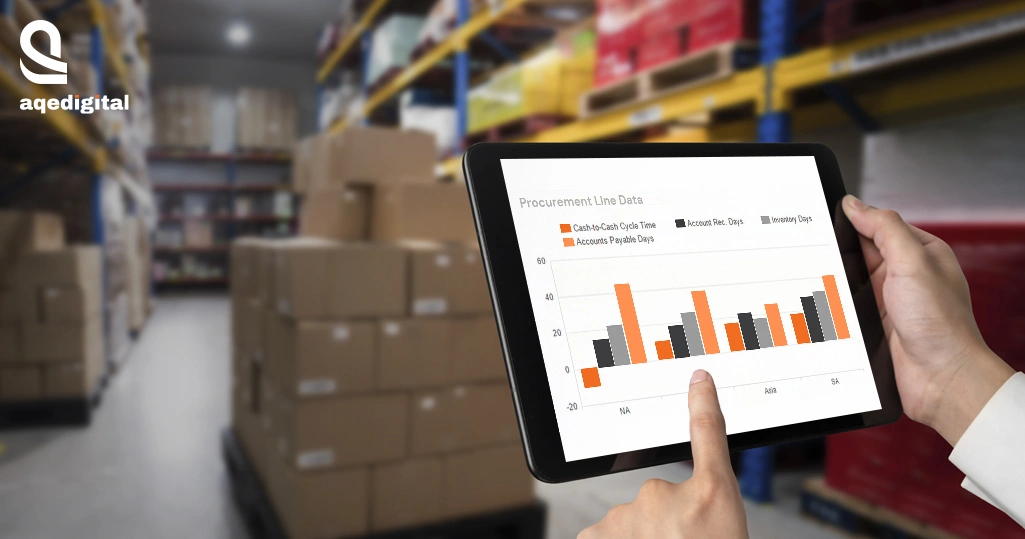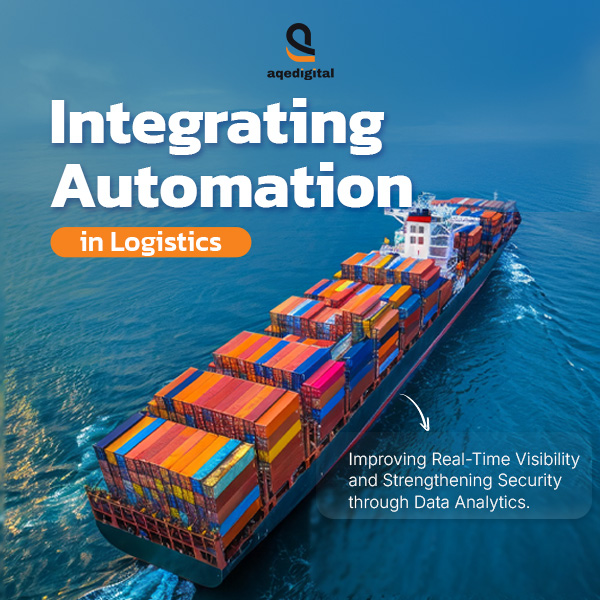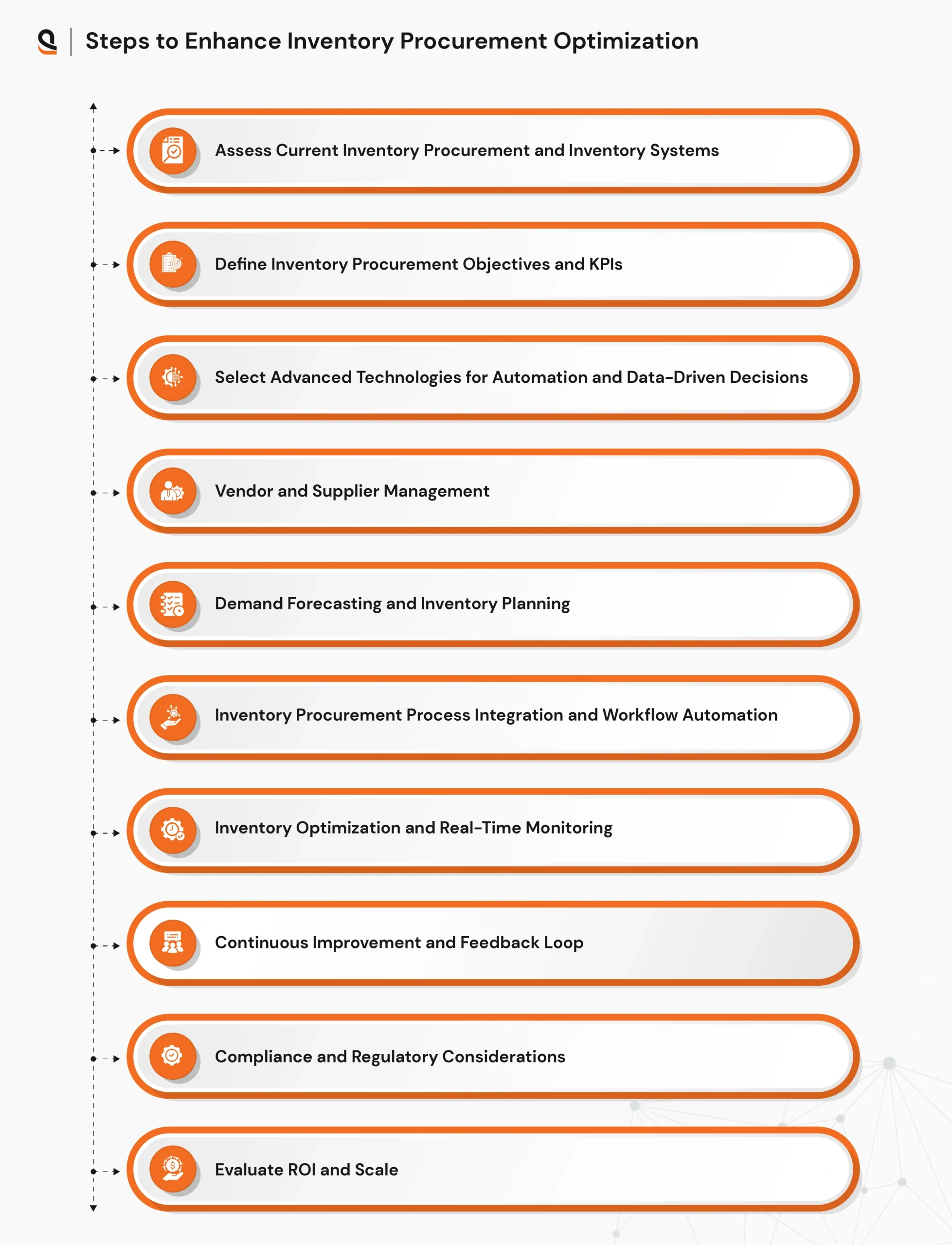
A lot of businesses end up losing about 30% of their working capital just sitting in excess inventory. So all that stock you’re holding might actually be draining your cash flow instead of helping it.
Overordering restrains cash flow in unsold inventory, which leads to increased storage costs, wasted resources, and even potential product obsolescence. Whereas, underordering or poor forecasting leads to stockouts, which means lost sales and frustrated customers who might turn to your competitors.
A robust automation in the inventory procurement optimization process ensures you have the right products at the right time and in the right quantity, which helps prevent both overstocking and stockouts.
By inventory procurement optimization, you maintain a healthy balance between supply and demand, improve cash flow, reduce waste, and enhance customer satisfaction—all of which contribute to a more efficient and profitable business.
Send download link to:
Integrating Automation in Logistics: Improving Real-Time Visibility and Strengthening Security through Data Analytics
First, Identify Your Challenges for Inventory Management in SCM
- Inability to Track Inventory Procurement and Supplier Performance in Real Time
- Inaccurate Predictions of Demand Lead to Stockouts or Overstocking
- Inconsistent Supplier Performance Hurts Delivery and Product Quality
- Slow Inventory Procurement Optimization Processes Lead to Bottlenecks and Delays
- Difficulty Maintaining Optimal Inventory Levels
- Data Fragmentation Across Departments Leads to Misalignment
- Confusing and Complex Supplier Pricing Makes Cost Comparison Hard
- Challenges in Managing Inventory Across Multiple Locations
- Resistance to New Technology Slows Process Improvements
- Unexpected Supply Chain Disruptions Lead to Major Delays
Priorities should be given to identified challenges, according to their level of importance. Some may affect, perhaps suddenly, cash flow or customer service; others may more have a long-term influence. It is important to understand which questions must be resolved first. For instance:
- Should be removed urgently-the high stockouts that rent both erys and customer experience into poor sales.
- The costs of holding excess inventory may need longer-term treatments, such as demand forecasting.
Our inventory optimization consulting services helps you reduce stockouts and overstocking, optimize supplier performance, and create a more transparent supply chain. We leverage AI-driven forecasting models to predict demand more accurately, ensuring that your inventory procurement optimization process is agile and responsive. Through our expert guidance, we can automate time-consuming manual tasks, speeding up inventory procurement optimization cycles, and improving supplier management.
- Curious to see it in action? Explore how a leading food manufacturer automated its procurement process with cloud solutions to boost efficiency and resilience.
Now, learn about the steps involved in establishing a robust inventory procurement optimization process for your inventory optimization.
Proven Ways to Enhance Inventory and Procurement Performance
Establishing robust inventory procurement processes for inventory optimization, especially with the inclusion of advanced inventory procurement and inventory management software technologies, can help streamline operations, reduce costs, and improve overall efficiency.Here’s a step-by-step guide to help you set up an optimized inventory procurement process:
1. Assess Current Inventory Procurement and Inventory Systems
- Review existing inventory procurement workflows, including how inventory is managed, how suppliers are engaged, and how products are tracked. Identify bottlenecks or inefficiencies.
- Understand the patterns in inventory movement, including seasonal demand, stockouts, overstock situations, and order lead times.
- Evaluate your current inventory procurement and inventory management software tools (ERP, procurement and inventory management software, inventory management in SCM systems) to identify their effectiveness and areas for improvement.
- Implement barcode scanning or RFID tracking to ensure real-time, accurate inventory counts. This method reduces human error and discrepancies, allowing you to spot issues as they arise, rather than during periodic audits.
2. Define Inventory Procurement Objectives and KPIs
- Establish clear objectives for inventory procurement, such as reducing stockouts, improving cash flow, optimizing inventory turnover, and reducing inventory procurement costs.
- Track key performance indicators such as inventory turnover rate, order cycle time, supplier lead time, cost per order, and demand accuracy.
| KPI | Higher value indicates… | Lower value indicates… |
| Inventory turnover rate | Efficient inventory management; products are sold and restocked quickly, reducing holding costs. | Slow-moving inventory; potential overstock, leading to higher holding costs. |
| Stockout rate | Lower stockouts; inventory is effectively managed, ensuring products are available when needed. | Frequent stockouts; inventory levels may be misaligned with demand, causing lost sales and customer dissatisfaction. |
| Lead time | Faster procurement and fulfillment process, improving efficiency. | Delays in procurement or production, leading to longer wait times for products. |
| Order cycle time | Shorter order cycles; faster processing and fulfillment, improving customer satisfaction. | Longer order cycles; delays in order processing and fulfillment, reducing customer satisfaction. |
| Supplier’s on-time delivery rate | Reliable suppliers; goods arrive as scheduled, reducing delays. | Unreliable suppliers; frequent delays in goods delivery, affecting operations and customer service. |
| Inventory holding costs | Lower holding costs; efficient inventory management, reducing storage and other related costs. | High holding costs; overstocking and poor inventory management increase storage and insurance expenses. |
| Demand forecast accuracy | Accurate demand forecasting, leading to optimized inventory levels and reduced stockouts/overstocks. | Poor forecasting accuracy, leading to misalignment between inventory levels and actual demand. |
| Percentage of automated orders | High automation, leading to increased efficiency, reduced manual errors, and faster order processing. | Low automation, relying on manual processes that may lead to errors, inefficiencies, and longer processing times. |
| Stock availability rate | High availability of stock; products are consistently available to meet customer demand. | Low availability of stock; frequent unavailability, leading to lost sales and poor customer satisfaction. |
| Supplier lead time variability | Low variability; suppliers consistently meet delivery schedules, improving planning and inventory management. | High variability; unpredictable supplier lead times, complicating inventory and demand management. |
| Perfect order rate | High perfect order rate; orders are delivered complete, on time, and without defects, improving customer satisfaction. | Low perfect order rate; frequent errors in order fulfillment, leading to dissatisfaction and operational inefficiencies. |
| ROI of Procurement Optimization | High ROI; cost-effective procurement strategies that yield significant benefits and savings. | Low ROI; inefficient procurement practices resulting in wasted resources and higher costs. |
- Set up occasional KPIs and use historical data to predict peak demand. For example, track lead times during your busiest months and aim to reduce them by a certain percentage year-over-year to avoid stockouts.
3. Select Advanced Technologies for Automation in Procurement
- An upgrade or implementation of a cloud-based ERP system would integrate procurement, inventory, sales, and finance into one platform for real-time data access and decision-making.
- With AI incorporated for demand forecasting, demand will be predicted more accurately through machine learning algorithms applied to analyze historical data, market trends, and seasonal variations.
- Routine processes in inventory procurement (like purchase order creation, supplier communication, etc.) should be automated to reduce manual errors and thus improve efficiency.
- IoT devices should be implemented in warehouses to track real-time inventory levels, automate restocking alerts, and monitor the condition of stored goods.
- Integrate all your systems (sales, procurement, inventory) into one unified ERP system which updates inventory levels in real-time across all departments, ensuring inventory procurement teams are operating off the most current data, thus minimizing order errors and omissions on excess stock.
4. Vendor and Supplier Management
- Use procurement and inventory management software tools to evaluate supplier performance based on quality, delivery times, and costs. You can set up automatic alerts for supplier performance issues.
- Automate vendor selection based on performance data and inventory procurement requirements. Implement a supplier portal that enables easy communication, order tracking, and automated reordering.
- Use predictive analytics to assess supplier risk based on geopolitical factors, financial health, and historical performance, and adjust inventory procurement strategies accordingly.
- Use a supplier performance monitoring system to track delivery times and quality in real-time. Set up automated alerts for any delays so you can quickly find alternative suppliers or make adjustments to your inventory procurement plans before a product launch.
5. Demand Forecasting and Inventory Planning
- Integrate AI-based demand forecasting tools to predict future demand patterns with high accuracy, helping to align inventory procurement with actual market needs.
- Adopt JIT inventory practices to reduce excess stock, decrease holding costs, and improve working capital. Use procurement and inventory management software to manage JIT processes efficiently.
- Implement algorithms that calculate the ideal safety stock level by factoring in lead time, demand variability, and supplier reliability.
- Implement IoT sensors in your warehouse to monitor stock conditions, like temperature and humidity, and track inventory movements in real-time. These sensors can alert you when stock conditions are unsuitable, allowing for immediate action to avoid spoilage.
6. Workflow Automation in Inventory Procurement Process Integration
- Setting up automation in inventory procurement such as requisition, approval workflows, purchase order, receipt, and invoicing.
- Consider e-procurement solutions for centralizing purchases: automate purchase orders, negotiate with suppliers, and even contract management using these platforms.
- Inventory procurement systems must therefore integrate tightly with inventory management tools to ensure that placing an order automatically updates inventory and generates alerts for reorder.
- Automate purchase order creation using demand forecasting tools that trigger automatic reorder notifications when stock hits predefined thresholds. This ensures that stock is replenished on time and minimizes human errors in order quantities.
7. Inventory Optimization and Real-Time Monitoring
- Use advanced procurement and inventory management software to set up automated reorder points, so inventory is replenished automatically based on sales velocity and predefined thresholds.
- Utilize AI in warehouse automation to dynamically allocate stock based on demand, location, and supply chain constraints. This ensures that inventory is optimized across multiple locations.
- Implement real-time inventory tracking systems with dashboards and alerts to help avoid stockouts and overstock situations.
- Set up automated alerts for slow-moving items to trigger promotions or price adjustments, while fast-moving items can be flagged for automatic reordering based on historical demand trends.
8. Continuous Improvement and Feedback Loop
- Automation in procurement techniques and performance must be continually tracked via dashboards. Procurement strategies, supplier associations, and inventory practices must be readjusted with real-time analytics.
- Use data to make decisions. Analytics tools should yield actionable insights to ensure procurement efficiency and inventory optimization.
- Ensure communication with suppliers through digital means, sharing forecasts and inventory levels to allow better alignment and minimize delays or shortages.
- Set up regular reviews and feedback loops with the sales and procurement teams to analyze cancellations and their causes. Utilize real-time analytics to uncover patterns and continuously refine inventory ordering and forecasting strategies.
9. Compliance and Regulatory Considerations
- Ensure that your automation in procurement processes comply with industry regulations, such as environmental standards, import/export restrictions, or labor laws.
- Implement systems to automatically track and report procurement activities for audit purposes. Use advanced reporting tools to generate compliance reports and ensure transparency.
- Implement a supplier portal where real-time communication, order tracking, and inventory levels are shared openly. This reduces delays by providing a transparent view of the order process and status updates for both your team and the suppliers.
10. Evaluate ROI and Scale
- After implementing your new procurement processes, use ROI analysis to measure the efficiency improvements and cost savings achieved through automation and optimization.
- Ensure that the new systems and processes can scale with your company’s growth. Cloud-based systems and AI tools can be particularly beneficial in growing businesses because they can handle increased demand without significant overhead.
- Use compliance monitoring tools that provide real-time updates on regulatory changes affecting procurement processes. Automate the tracking of import/export documentation and ensure all suppliers meet the latest industry standards and legal requirements.
How Can AQe Digital Help Optimize Inventory Management?
Our ERP software development services focus on inventory optimization, delivering solutions through a robust retail procurement strategy, covering accurate demand forecasting, real-time inventory tracking, and automated procurement processes. These elements contribute to smarter decision-making and significant cost savings. Our team evaluates your current workflows to identify improvement opportunities and provide insights aligned with your business goals.
- Automate Your Way to Success – We streamline procurement with end-to-end automation, reducing manual tasks and speeding up workflows.
- Real-Time Insights for Smarter Decisions – Get access to real-time data dashboards that empower teams to make informed, data-backed decisions.
- Cost Savings You Can Count On – Reduce operational costs with our strategic supplier management, optimized stock levels, and demand forecasting.
- Transform Complexity into Simplicity – Simplify multi-location inventory management with a centralized, automated system.


